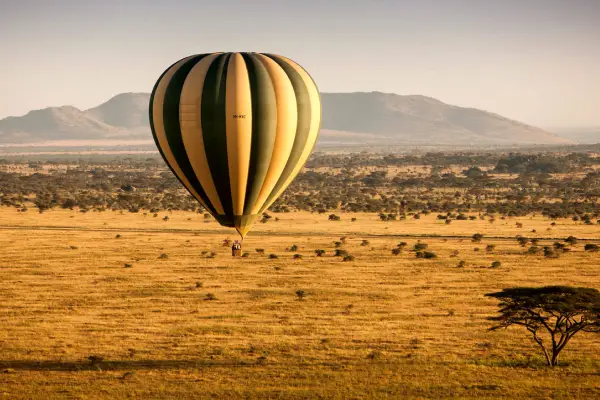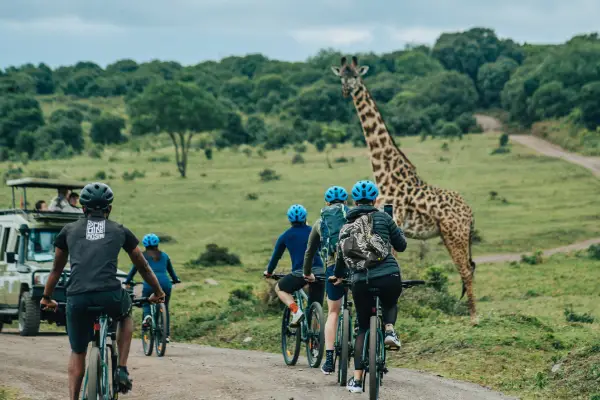100% refundable deposits
100% refundable deposits
Tanzania enjoys a warm climate, so it's best to wear light, breathable clothing like cotton or linen. For game viewing safari, opt for neutral colours such as white, beige, khaki, or brown to blend into the surroundings.
Light, comfortable clothes are ideal for long days in Tanzania Safari vehicles. Avoid denim as it can get quite uncomfortable in the heat and adversely affect your Tanzania Safari Experience.
In the cooler evenings, consider long-sleeved shirts, trousers, and possibly a sweater to protect against the chill and insects.
Always wear a hat for sun protection. For women, remember to dress modestly in public areas, as Tanzania has a significant Muslim population.
Packing light is advisable as many lodges offer laundry services. Remember to bring sturdy shoes for walking and a waterproof jacket for unpredictable weather.
Essentials of a Safari Packing List Tanzania include a swimsuit for the warm weather in Zanzibar, lightweight cotton clothing, and sandals. Packing a first-aid kit, a torch, a reusable water bottle, binoculars, and a camera will enhance your Safari Tour in Tanzania experience. For flights, soft luggage is required with a maximum weight of 20kg.
While there are no mandatory vaccinations for entry into Tanzania, a Yellow Fever vaccination is required if you're coming from a country with Yellow Fever transmission or have transited for over 12 hours in such a country. Although COVID-19 vaccinations and tests are not currently required, it's crucial to check the latest Tanzania Health & Safety guidelines before travel. As malaria is prevalent, taking prophylactics is strongly advised for your Tanzania Safari.
Tanzania uses the UK-style plug. Travelers from Europe should bring a travel adapter. The standard voltage is 230 volts AC / 50 Hz. If your device is not compatible with this voltage, a voltage converter is necessary for your stay during the Tanzania Safari Tours.
Most lodges provide free WiFi, although the quality and speed can vary. It's generally sufficient for checking emails or using WhatsApp, but not for streaming or downloading large files. For mobile internet, purchasing a local SIM card, such as one from Airtel, is recommended for the best coverage during your Safari in Tanzania.
Tanzania's vast size means its climate varies. The main rainy season, or 'long rains', lasts from March to May. The long dry season from June to October offers clear skies and sunny days, ideal for visiting. The 'short rains' occur in November and December, followed by the 'short dry season' in January and February, making these months great for safaris in Tanzania. This explains why it's important to consider the best time to visit Tanzania.
Travelling between parks and reserves in Tanzania can be accomplished by road or air, which is essential to know when considering how to get to Tanzania and get around Tanzania.
Roads, especially in remote areas, can be challenging, making it advisable to hire a local driver-guide. For quicker transportation, flights are available between major parks and cities.
Airlines like Air Tanzania and Coastal Air offer regular services, including routes to and from Zanzibar and other key destinations, making it easier to navigate the best safari experiences in Tanzania.
The Tanzanian Shilling is the local currency, and cash transactions are common. US dollars are also widely accepted, especially newer bills in good condition.
Credit cards and travellers' checks are less commonly accepted and may incur high fees.
Banks are typically open from 9:00 am to 3:00 pm, Monday to Friday, with ATMs available 24/7 for your convenience during the Tanzania Safari Trip.
While most tourist accommodations provide Western-style food that is safe, it is advisable to drink bottled or filtered water. Tap water is generally not safe to drink. It's also wise to specify any dietary requirements in advance, as options may be limited in remote areas during your Tanzania Safari Tours.
Our camping Safaris in Tanzania feature high-quality, handmade canvas tents that provide excellent protection against the elements. These tents are spacious and well-equipped to ensure a comfortable experience in the wild during your Best Tanzania Safari Packages.
Our Tanzania Safari Costs for camping safaris include park entry fees, transport, game drives, camping fees, services of a driver/guide, cook, all meals, drinking water, and camping equipment. Lodge safaris include similar services with lodge accommodations instead of camping.
Meals on our camping safaris are nutritious and enjoyable, catering to various dietary preferences. You'll enjoy freshly prepared breakfasts, dinners, and packed lunches for daytime excursions during your Tanzania Travel journey.

All itinerary activities with a local, certified guide

We provide Kailas X3 III alpine tents with vestibules

All nutritious meals while on the trek.

To and from the airport and everything in between

All permit fees and taxes

Solo-friendly by nature, join our small groups



 25°C
25°C
 45MM
45MM
January is a lush and vibrant time in the Serengeti, marking the peak of the calving season. The southern plains come alive with newborn wildebeests and zebras, offering a spectacular wildlife experience. The weather is warm with occasional showers, creating a green and flourishing landscape. This period is ideal for observing young animals and their interactions with predators, all while enjoying a relatively quiet park with fewer tourists.
 25°C
25°C
 45MM
45MM
February continues the calving season with a high concentration of newborns across the southern Serengeti. The lush vegetation supports large herds of wildebeest and zebra, and predator activity remains high, making it an exciting time for wildlife viewing. The weather remains warm with occasional rains, and the park is still less crowded, providing excellent opportunities for intimate wildlife experiences.
 25°C
25°C
 45MM
45MM
By March, the calving season begins to wind down, and the herds start moving northward. The landscape remains green and vibrant due to ongoing rains, but the vegetation starts to thicken, which can make wildlife spotting more challenging. However, the park’s reduced number of visitors means a more serene safari experience, and the start of the migration northward offers exciting prospects for observing the moving herds.
 25°C
25°C
 45MM
45MM
April is characterized by heavy rains, making it one of the wettest months in the Serengeti. The landscape transforms into a lush paradise, but the roads can become muddy and challenging to navigate. Wildlife viewing can be more difficult due to dense vegetation and wet conditions, but the park’s reduced tourist numbers offer a quieter experience and a unique opportunity to see the park in its most verdant state.
 25°C
25°C
 45MM
45MM
May continues with the long rains, maintaining the park’s lush, green appearance. The increased vegetation can obscure wildlife, making sightings more difficult. However, this is a less crowded time, providing a peaceful safari experience. As the migration herds start moving north, there are opportunities to witness the beginnings of the migration, offering a quieter but still engaging wildlife experience.
 25°C
25°C
 45MM
45MM
June marks the beginning of the Avg Temperature, with warm, pleasant weather and minimal rainfall. The landscape starts to dry out, and wildlife concentrations increase around water sources, making it easier to spot animals. The Great Migration typically begins its journey northward, and the park’s clearer conditions provide excellent opportunities for viewing river crossings and large gatherings of wildlife.
 25°C
25°C
 45MM
45MM
July is one of the prime months to visit the Serengeti, as the Avg Temperature is in full swing. The Great Migration reaches the northern Serengeti, where dramatic river crossings occur. The dry conditions ensure clear visibility and easier access to wildlife, though it is also the height of the tourist season. The warm weather and high concentrations of wildlife make for an unforgettable safari experience.
 25°C
25°C
 45MM
45MM
August continues with excellent conditions for wildlife viewing as the Great Migration remains in the northern Serengeti. The dry, warm weather makes for clear skies and easy access to the park’s various wildlife hotspots. This is an ideal time for witnessing the spectacular river crossings and observing large predator populations, though it can be quite busy with tourists.
 25°C
25°C
 45MM
45MM
In September, the Avg Temperature persists, providing excellent conditions for game viewing. The Great Migration herds are still moving south, and wildlife remains concentrated around water sources. The dry weather and open landscapes make it easier to spot animals, and the crowds start to thin out slightly, offering a more relaxed safari experience compared to peak months.
 25°C
25°C
 45MM
45MM
October marks the transition from the Avg Temperature to the short rains. The Great Migration herds continue their southward movement, and wildlife is concentrated around remaining waterholes. The landscape begins to show signs of green as the rains approach, and the park sees fewer tourists, making for a more tranquil and enjoyable safari experience.
 25°C
25°C
 45MM
45MM
November brings the start of the short rains, with occasional showers and a rapidly greening landscape. The migration herds continue moving south, and the park’s transformation into a lush environment offers beautiful scenery. The reduced number of visitors and vibrant landscape provide a serene and picturesque safari experience.
 25°C
25°C
 45MM
45MM
December features ongoing short rains, which further enhance the park’s lush and green appearance. The calving season begins in the southern Serengeti, with herds returning and newborn animals becoming more common. The warm weather and vibrant environment, combined with fewer tourists, create an ideal setting for observing new life and enjoying a peaceful safari.

Talk to Us. Our Experts are just a Click Away!












I hiked Killimanjaro with a local company called Ascend Tanzania. I could not recommend a company more highly.






I had no idea what I was signing up for when I decided, without any prior experience of a trek of this calibre






Climbing Kilimanjaro was one of my greatest mountain experience so far.






Ascend is a top-notch Kilimanjaro tour guide company that I would highly recommend






Ascend tanzania is an affordable company run by the most efficient local people!
"Excellent Company To Climb With"
I booked my Kilimanjaro climb (6 Day Machame route) with Ascend Tanzania because I was travelling solo and on a budget
Read Reviews